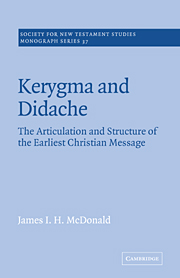Summary
Through the many-sided experiences-within-community which we have noted in the foregoing chapters, the followers of Jesus came to conceive, articulate, communicate and develop their message. ‘Their’ message only in a paradoxical sense: for while they undoubtedly struggled towards understanding and articulating it, there was always a sense in which it was ‘given’ or a sense in which they were ‘led into truth’, for the object of their message transcended their full comprehension and ‘blicks’ or insights into reality came not by human contrivance but through openness to the transcendent. In the concrete reality of Jesus the Christ, the transcendent had been expressed in human terms, as ‘good news’ in word and action. The ‘word’ was largely the paradosis originating with Jesus, interpreting and interpreted by the word of scripture. The ‘action’ was many-stranded: the ‘action’ of the death of Jesus, of the resurrection experiences and the Spirit, of common meals and ‘remembering’, of searching the scripture, and of the koinonia as a whole. The proclamation of the Christ event as ‘good news’ was now to be accomplished in similar fashion, in word and action (cf. John 3:18).
The experience of the Christian koinonia has to be translated into intelligible terms for the purposes of edification (cf. 1 Cor. 14:1-19), evangelism and apologetic exposition (cf. Acts 2:14ff.).
- Type
- Chapter
- Information
- Kerygma and DidacheThe Articulation and Structure of the Earliest Christian Message, pp. 126 - 132Publisher: Cambridge University PressPrint publication year: 1980

